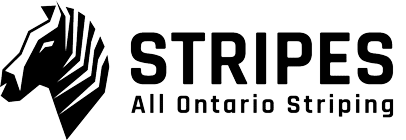Floor-Marking
Warehouse floors need lines and signs for two reasons: Safety and Efficiency.
Stripes has significant experience floor-marking across the GTA. Just consider these industries and organizations:
|
Transportation Toronto Transit Commission (TTC) |
Utilities Toronto Hydro |
Food Production Ital Pasta and Yaya Foods |
|
Logistics Direct Distribution and Emblem Logistics |
Publishing Metroland Media |
Clothing Wolverine Shoes |
|
Plastics Salbro Bottle |
Ceramics Anatolia Tiles |
Floor-Marking for Safety – It’s the Law!
Occupational Health and Safety Regulations require workplaces to clearly mark:
- Pedestrian Pathways, and
- Passageways leading to an open door or gate
Some other markings are not required by-law, but they improve workplace safety and efficiency.
- Hazardous areas
- Different work areas
- Locations for products or equipment
- Traffic route signs
Step 1: Determining your traffic levels
How much traffic flows in your area?
Foot traffic is “light traffic.” Forklifts, pivoting wheels and dragging pallets are “heavy traffic.”
This chart helps define your traffic level.
TRAFFIC LEVELS
| Light | Medium | Heavy | Extreme |
|
|
|
|
Step 2: Selecting your materials
The top choices are paint or tape.
Paint is a good choice for light to medium traffic areas. Paint is also usually the cheapest option.
| Advantages of Traffic Paint | Disadvantages of Traffic Paint |
|
|
Application of a sealer over the paint makes it collect less dirt and easier to clean.
Heavy and Extreme Traffic Levels
Epoxy solutions are best for heavy and extreme traffic areas. Epoxy solutions are more expensive than traffic paint, but worth the investment.
| Advantages of Epoxy Floors | Disadvantages of Epoxy Floors |
|
|
Traffic Marking Tape
| Advantages of Traffic Marking Tape | Disadvantages of Traffic Marking Tape |
|
|
Step 3: Preparing your floor
This step is crucial. Start by preparing your concrete – it will give your floor markings longer life!
In this stage, we prepare the floor by eliminating oil and dirt, removing thin top layer exposing a clean bare unsealed surface.
Some of our main techniques are:
- Using solvents to clean floors
- Applying sealer over cured concrete – filling pores, binding dust particles and forming a water-resistant film on the surface
- Mechanical abrasion, including:
- Shot Blasting – firing small beads to strip the smooth finish surface to expose a roughened concrete surface that is ideal for adhering paint, or
- Diamond Shaving – “shaving” away 1mm to 5mm of the surface creating a channel. The paint is applied to the channel creating a recessed line level with the original floor surface.
Gallery

Warehouse Lines www.instagram.com/allontariostriping 
Warehouse Lines www.instagram.com/allontariostriping

Warehouse Lines
www.instagram.com/allontariostriping














